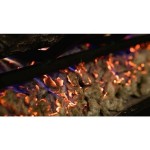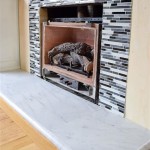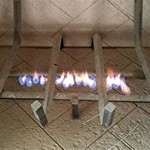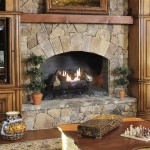Cast Iron Wood Fireplace Inserts: A Comprehensive Guide
Cast iron wood fireplace inserts represent a significant upgrade to traditional open fireplaces. They offer enhanced heating efficiency, improved safety, and a more controlled burning environment. This article provides a detailed overview of cast iron wood fireplace inserts, covering their features, benefits, installation considerations, and maintenance requirements. Understanding these aspects can help homeowners make informed decisions about selecting and utilizing a cast iron wood fireplace insert for supplemental heating.
The fundamental purpose of a fireplace insert is to transform an existing, often inefficient, masonry fireplace into a more effective heating appliance. Traditional open fireplaces lose a substantial amount of heat up the chimney, often drawing warm air from the room. A fireplace insert, sealed within the existing firebox, minimizes heat loss and radiates heat into the living space. Cast iron, specifically, is chosen for its excellent heat retention and distribution properties, making it an ideal material for fireplace inserts.
A cast iron wood fireplace insert comprises several key components. The firebox, typically constructed entirely of cast iron, houses the burning wood. An airtight door, often with a glass viewing panel, controls airflow and prevents smoke from entering the room. A flue collar connects the insert to the chimney liner, ensuring proper venting of combustion gases. Blower fans, often integrated into the insert design, circulate heated air into the room, further enhancing heating efficiency. Other features may include a damper control for regulating airflow, an ash pan for easy ash removal, and a catalytic combustor or secondary burn system to reduce emissions and improve fuel efficiency.
Key Advantages of Cast Iron Construction
The choice of cast iron as the primary material for fireplace inserts offers several distinct advantages. Firstly, cast iron boasts exceptional heat retention capabilities. It absorbs heat efficiently from the burning wood and retains it for an extended period, even after the fire has died down. This allows the insert to continue radiating heat into the room, providing sustained warmth and reducing the frequency of refueling.
Secondly, cast iron excels at distributing heat evenly. Its dense and uniform structure ensures that heat is conducted consistently throughout the insert, preventing hot spots and promoting a more even heat output. This characteristic contributes to a comfortable and consistent heating experience within the room. The even heat distribution also minimizes the risk of warping or cracking due to uneven thermal stress.
Thirdly, cast iron is renowned for its durability and longevity. A well-maintained cast iron fireplace insert can last for decades, providing reliable heating performance for years to come. The robust construction of cast iron resists deformation and degradation, even under high temperatures and prolonged use. This makes it a cost-effective investment in the long term, as it reduces the need for frequent repairs or replacements.
The thickness and quality of the cast iron used in the insert's construction directly impact its performance and lifespan. Thicker cast iron generally provides better heat retention and durability. Similarly, the quality of the casting process and the composition of the cast iron alloy influence its resistance to cracking and corrosion.
Factors to Consider When Choosing a Cast Iron Wood Fireplace Insert
Selecting the appropriate cast iron wood fireplace insert requires careful consideration of several factors. The size of the fireplace opening is a critical determinant. The insert must fit snugly within the existing firebox, with adequate clearance around the sides and top for proper air circulation and installation. Measuring the fireplace opening accurately is essential to ensure a proper fit.
The heating capacity of the insert, measured in British Thermal Units (BTUs), should be appropriate for the size of the space being heated. An undersized insert will struggle to provide adequate heat, while an oversized insert may overheat the room and consume excessive fuel. It’s important to accurately assess the heating requirements of the space, taking into account factors such as insulation levels, window area, and climate.
The efficiency rating of the insert, typically expressed as a percentage, indicates how much of the fuel's energy is converted into usable heat. Higher efficiency ratings translate to lower fuel consumption and reduced heating costs. Inserts with EPA certification meet stringent emissions standards and often feature advanced combustion technologies such as catalytic combustors or secondary burn systems to improve efficiency and reduce pollution.
The insert's features and design should also be considered. A glass door allows for viewing the fire and adds to the aesthetic appeal. A blower fan enhances heat circulation and improves heating efficiency. An ash pan simplifies ash removal and maintenance. The overall design of the insert should complement the existing décor of the room.
Manufacturers offer various styles and finishes for cast iron wood fireplace inserts. These options include traditional designs with decorative castings and ornate details, as well as more contemporary styles with clean lines and minimalist aesthetics. Choosing a style that aligns with the homeowner’s personal preferences and complements the existing décor is an important consideration.
Installation and Safety Considerations
Proper installation is crucial for the safe and efficient operation of a cast iron wood fireplace insert. It is highly recommended to have the insert installed by a qualified professional with experience in fireplace insert installations. Incorrect installation can lead to safety hazards such as carbon monoxide poisoning, chimney fires, and reduced heating efficiency.
A key aspect of the installation process is the installation of a chimney liner. The liner provides a continuous, airtight pathway for combustion gases to escape from the insert to the top of the chimney. Without a liner, creosote buildup can accumulate in the chimney, increasing the risk of a chimney fire. The liner should be made of stainless steel and sized appropriately for the insert's flue collar. It is also crucial to ensure that the chimney is structurally sound and free from any defects.
Proper ventilation is essential for the safe operation of a wood-burning fireplace insert. The insert should be installed in a well-ventilated room to ensure adequate air supply for combustion. Carbon monoxide detectors should be installed in the room and on every level of the home to provide early warning of any carbon monoxide leaks. Regular inspections and maintenance of the insert and chimney are essential to ensure safe and efficient operation.
Safe wood-burning practices are also important. Only seasoned, dry wood should be used, as it burns more efficiently and produces less creosote. Overloading the firebox should be avoided, as it can lead to excessive smoke and creosote buildup. The damper should be adjusted appropriately to control airflow and prevent excessive draft. Regular cleaning of the chimney is necessary to remove creosote buildup and prevent chimney fires.
Consider the specific building codes and regulations applicable to wood-burning appliances in your area. Local codes may dictate specific requirements for installation, venting, and emissions. Compliance with these codes is essential for ensuring safety and avoiding potential penalties.
Maintenance and Care of Cast Iron Wood Fireplace Inserts
Regular maintenance is essential for preserving the performance and extending the lifespan of a cast iron wood fireplace insert. Daily maintenance tasks include removing ashes from the firebox and cleaning the glass door. Ashes should be disposed of in a metal container with a tight-fitting lid and placed away from combustible materials. The glass door can be cleaned with a specialized fireplace glass cleaner to remove soot and grime.
Periodic inspections of the insert and chimney are also necessary. The chimney should be inspected annually by a qualified chimney sweep to check for creosote buildup, cracks, and other damage. The insert should be inspected for cracks, leaks, and worn-out parts. Any necessary repairs or replacements should be performed promptly to maintain the insert's performance and safety.
Proper storage of firewood is essential for maintaining its quality and ensuring efficient burning. Firewood should be stored in a covered and well-ventilated area to prevent it from getting wet or moldy. Wet or moldy wood burns inefficiently and produces excessive smoke and creosote. Seasoning firewood for at least six months before burning is recommended to reduce its moisture content and improve its burning characteristics.
Cast iron surfaces can develop rust over time, especially in humid environments. Applying a thin coat of stove polish or high-temperature paint can help protect the cast iron from rust and maintain its appearance. Follow the manufacturer's instructions carefully when applying these products.
Regular cleaning and maintenance not only improve the performance and lifespan of the insert but also ensure safe and efficient operation. By following a diligent maintenance routine, homeowners can enjoy the warmth and comfort of their cast iron wood fireplace insert for many years to come.

Napoleon Epi3 Wood Fireplace Insert Inserts By Rockford Chimney

Ventis Hei240 Wood Fireplace Insert Mace Energy Supply

Expedition Ii Wood Insert Forge Flame

Tpi3 1 Series Timberwolf Wood Fireplace Insert Hearth Stove Patio

Hi2450 Non Catalytic Cast Iron Wood Insert By Regency

Wood Fireplace Inserts Lopi Stoves Made In Usa

Buy Regency Hampton Cast Iron Pellet Insert Or In

Timberwolf Medium Wood Burning Cast Iron Fireplace Insert T25i Tri State Fireplaces

Timberwolf Wood Fireplace Insert Cast Iron Surround And Fireplaces Usa

Montpelier Ii Cast Iron Wood Insert Majolica Brown Fireside Home Solutions
Related Posts








